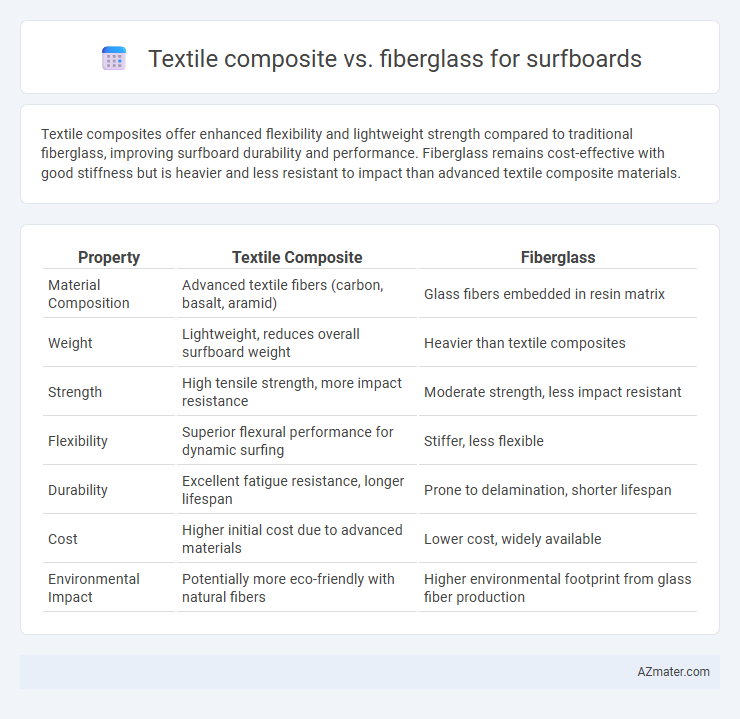Textile composites offer enhanced flexibility and lightweight strength compared to traditional fiberglass, improving surfboard durability and performance. Fiberglass remains cost-effective with good stiffness but is heavier and less resistant to impact than advanced textile composite materials.
Table of Comparison
| Property | Textile Composite | Fiberglass |
|---|---|---|
| Material Composition | Advanced textile fibers (carbon, basalt, aramid) | Glass fibers embedded in resin matrix |
| Weight | Lightweight, reduces overall surfboard weight | Heavier than textile composites |
| Strength | High tensile strength, more impact resistance | Moderate strength, less impact resistant |
| Flexibility | Superior flexural performance for dynamic surfing | Stiffer, less flexible |
| Durability | Excellent fatigue resistance, longer lifespan | Prone to delamination, shorter lifespan |
| Cost | Higher initial cost due to advanced materials | Lower cost, widely available |
| Environmental Impact | Potentially more eco-friendly with natural fibers | Higher environmental footprint from glass fiber production |
Introduction: Surfboard Material Evolution
Surfboard material evolution has shifted from traditional fiberglass reinforcements to advanced textile composites, enhancing performance and durability. Textile composites offer superior strength-to-weight ratios and improved flexibility compared to conventional fiberglass, contributing to better maneuverability on waves. Innovations in composite fabrics have also increased environmental sustainability by enabling the use of bio-based resins and reducing manufacturing waste.
What Are Textile Composites?
Textile composites for surfboards consist of woven fibers such as carbon, basalt, or natural fibers combined with resin matrices, offering enhanced strength-to-weight ratios and flexibility compared to traditional fiberglass. Unlike fiberglass, textile composites provide superior durability, impact resistance, and environmental sustainability due to their customizable fabric architecture and use of bio-based fibers. These properties make textile composites a cutting-edge choice for high-performance surfboards, delivering increased performance through improved mechanical properties and reduced environmental footprint.
Understanding Fiberglass in Surfboards
Fiberglass in surfboards consists of woven glass fibers bonded with resin to create a strong, lightweight shell that enhances durability and flex performance. Textile composites, on the other hand, incorporate advanced fabrics like carbon fiber or basalt, offering superior strength-to-weight ratios and improved impact resistance compared to traditional fiberglass. Understanding fiberglass's role reveals its cost-effectiveness and ease of repair, making it a popular choice despite newer composites providing enhanced performance for high-end surfboards.
Strength and Durability Comparison
Textile composites typically offer superior tensile strength and impact resistance compared to fiberglass, making them highly durable for surfboards subjected to rough ocean conditions. Fiberglass, while lighter and more flexible, tends to have lower fatigue resistance and is more prone to cracking under heavy stress. Advanced textile composites utilize woven fibers and resin systems that enhance structural integrity and extend the board's lifespan, outperforming traditional fiberglass in long-term durability.
Weight Differences and Performance Impact
Textile composites are generally lighter than fiberglass, offering enhanced maneuverability and reduced fatigue for surfers during extended sessions. The lower weight of textile composites contributes to quicker acceleration and improved responsiveness on waves, allowing for more precise turns and aerial maneuvers. Fiberglass, while heavier, provides durability and stiffness but can negatively impact board speed and agility compared to advanced textile composite materials.
Flexibility and Ride Feel
Textile composites offer superior flexibility compared to fiberglass, allowing surfboards to absorb wave energy more effectively for a smoother, more responsive ride. Fiberglass, while stiffer and more durable, provides a firmer feel underfoot that suits surfers seeking aggressive performance and quick turns. The enhanced elasticity of textile composites enhances maneuverability, making them ideal for riders prioritizing comfort and dynamic wave interaction.
Environmental Sustainability
Textile composites for surfboards typically offer enhanced environmental sustainability compared to traditional fiberglass due to their use of natural fibers like flax or hemp, which are biodegradable and have a lower carbon footprint. Fiberglass production relies on energy-intensive processes and non-renewable petroleum-based resins, contributing to higher CO2 emissions and longer degradation times in marine environments. Utilizing bio-based epoxy resins with textile composites further reduces environmental impact, promoting eco-friendly surfboard manufacturing and disposal.
Cost Analysis: Textile Composite vs Fiberglass
Textile composite surfboards typically incur higher upfront costs due to advanced materials and manufacturing processes, whereas fiberglass boards offer more affordable production with widespread availability. Maintenance expenses for textile composites are lower over time, as these materials provide superior durability and resistance to water damage compared to fiberglass, which may require frequent repairs. Evaluating total lifecycle costs reveals that textile composites, despite higher initial investment, can offer better long-term value than traditional fiberglass options.
Popular Use Cases and Rider Preferences
Textile composites in surfboards offer superior flexibility and lightweight performance, making them popular among professional riders seeking advanced maneuverability and responsiveness in competitive waves. Fiberglass remains the preferred choice for beginners and casual surfers due to its durability, affordability, and ease of repair, providing a reliable option for everyday use and varied water conditions. Rider preferences often hinge on performance needs versus budget constraints, with textile composites favored in high-performance and custom boards, while fiberglass caters to durability and accessibility for a broader audience.
Future Trends in Surfboard Materials
Textile composites are emerging as a sustainable alternative to traditional fiberglass in surfboard manufacturing, offering enhanced flexibility, strength, and reduced environmental impact through the use of natural fibers like flax and hemp. Innovations in bio-based resins combined with textile composites are driving the development of lighter, more durable surfboards with improved performance in diverse wave conditions. Future trends indicate a growing shift toward eco-friendly materials that blend advanced textile engineering with surf-specific design to meet the demands of environmentally conscious surfers and manufacturers.

Infographic: Textile composite vs Fiberglass for Surfboard
 azmater.com
azmater.com